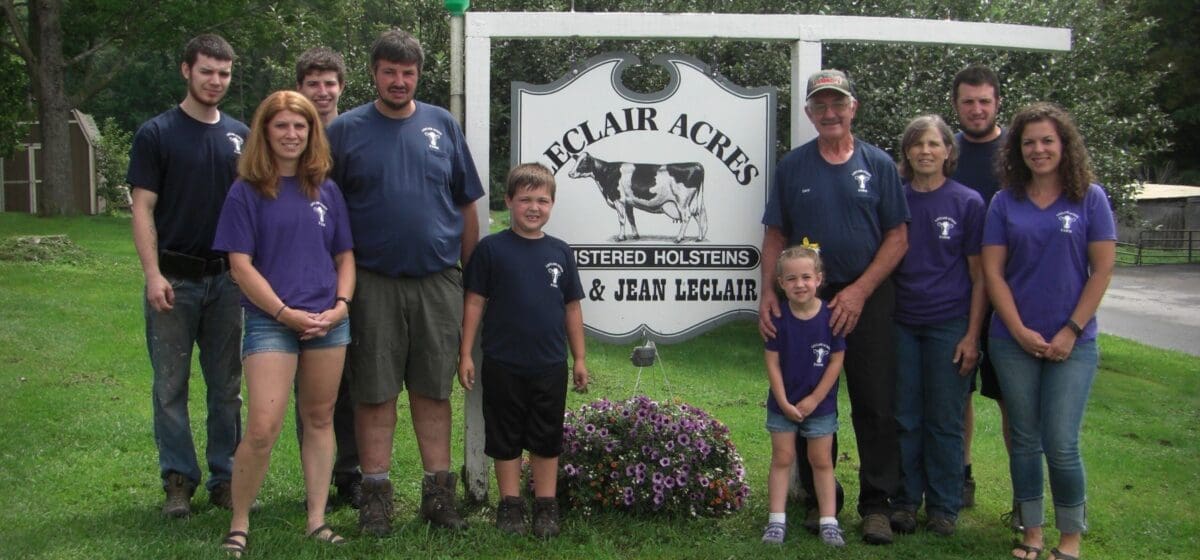“We thought, ‘If we’re going to work seven days a week, why not work for ourselves?’” – Gairy LeClair
Gary LeClair will tell you that dairy farmers should appreciate that their operations are part of the local landscape. Sure, dairy farmers rarely have time to think about such things – they’re a busy bunch, after all – but Gary recalls one fellow stopping him one day to ask him about what caused his corn to fall over.
Yes, the locals notice things like that, it seems, and lots of people often stop by the LeClair Acres farm stand to chat. They’ll reminisce about their grandfather’s farm or ask about the LeClair place, but their questions are all tied to a curiosity and an appreciation of farmers and farming.
And that’s as it should be, says LeClair, whose farm in Claremont was named New Hampshire’s Dairy Farm of the Year in 2018. This award is given every year to one outstanding dairy farm in each of the New England states. Winners are evaluated on production records; herd, pasture, and crop management; environmental practices; contributions to agriculture and the local community; and overall excellence in dairying.
LeClair Acres Farm dates back to 1926, when Gary’s grandfather purchased the farm with 120 acres of land. Gary’s father, Henry, continued farming until 1976 when the farm was auctioned. After the sale, Gary and his wife, Jean, worked her father’s dairy farm, but that made little sense, says Gary. “We thought, ‘If we’re going to work seven days a week, why not work for ourselves?’” Two years later, after borrowing money to start back up, Gary and Jean bought the LeClair Acres Farm back with 22 cows of their own, later buying another 36 soon after the farm purchase.
Since those early years, the couple has focused on slow, steady growth with a few more cows and land purchases. Today, the farm consists of a total of 410 acres and 250 milking cows.
It’s a fairly large operation for a New Hampshire dairy, but Gary has it under control thanks to a smart phone app called Pocket Cow Card (PCC). There are still paper records and constant on-site monitoring, but with a push of a button, Gary can tell you when cow #52 was milked and how much she produced.
The speed with which Gary has embraced technology is only outdone by the furious pace of other improvements on the farm. The LeClairs have remodeled the milking parlor twice, the first time replacing a four-stall parlor with a double-five parlor in only one month’s time. The recent upgrade in 2015 took just two days, when they went from a double-eight to a double-ten stainless steel parlor and they remodeled the building to boot.
Over the past 40 years, Gary and Jean have employed local high school students as occasional help, and the farm currently has a few part-time employees. The full-time labor comes from family members who contribute to the daily management, with responsibilities informally divided. In addition, there are two full-time employees sharing daily chores.
Gary and son, Jason, manage the cow herd and crops, with Jason managing the feed, nutrition, equipment, and day-to-day employees. Jean runs the business side of the farm on a daily basis and milks the cows with Gary every morning, while Jason’s wife, Tonya, feeds the calves. You might also spot Jean in corn season riding the tractor, packing corn silage on the bunk silo.
Recently, Jean and Gary, along with son Tim and wife Cory, ventured into the direct customer marketing side of farming and started a small vegetable stand selling sweet corn and a variety of vegetables. Tim helps Gary with veggies, and Cory bakes bread, cookies, and muffins for the farm stand, as well as creates relish and jam. Tim is also busy in the late winter with maple sugaring, to create the popular syrup sold at the stand year-round.
That stand is where many locals visit to talk about the weather or the corn that fell over. Gary doesn’t mind. “So many people come by just to talk,” he says. “Whenever I get a chance, I stop and chat. It’s a chance to share the story of agriculture, and to promote agriculture.”
You might say Gary and Jean, like his farm, have become part of the local landscape, too.

